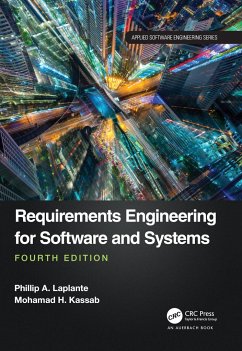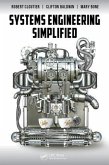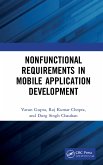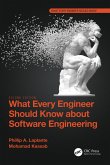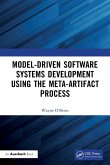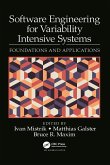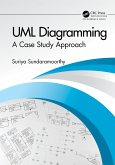Phillip A. Laplante (The Pennsylvania State University, Malvern, US, Mohamad Kassab
Requirements Engineering for Software and Systems
Phillip A. Laplante (The Pennsylvania State University, Malvern, US, Mohamad Kassab
Requirements Engineering for Software and Systems
- Broschiertes Buch
- Merkliste
- Auf die Merkliste
- Bewerten Bewerten
- Teilen
- Produkt teilen
- Produkterinnerung
- Produkterinnerung
This textbook provides a comprehensive treatment of the theoretical and practical aspects of discovering, analyzing, modeling, validating, testing, and writing requirements for software systems. New chapters examine nonfunctional requirements and requirements of systems using disruptive technologies such as blockchain.
Andere Kunden interessierten sich auch für
![Systems Engineering Simplified Systems Engineering Simplified]() Robert Cloutier (University of South Alabama)Systems Engineering Simplified63,99 €
Robert Cloutier (University of South Alabama)Systems Engineering Simplified63,99 €![Nonfunctional Requirements in Mobile Application Development Nonfunctional Requirements in Mobile Application Development]() Varun GuptaNonfunctional Requirements in Mobile Application Development48,99 €
Varun GuptaNonfunctional Requirements in Mobile Application Development48,99 €![What Every Engineer Should Know about Software Engineering What Every Engineer Should Know about Software Engineering]() Phillip A. Laplante (The Pennsylvania State University, Malvern, USWhat Every Engineer Should Know about Software Engineering68,99 €
Phillip A. Laplante (The Pennsylvania State University, Malvern, USWhat Every Engineer Should Know about Software Engineering68,99 €![Model-Driven Software Systems Development Using the Meta-Artifact Process Model-Driven Software Systems Development Using the Meta-Artifact Process]() Wayne O'BrienModel-Driven Software Systems Development Using the Meta-Artifact Process68,99 €
Wayne O'BrienModel-Driven Software Systems Development Using the Meta-Artifact Process68,99 €![Software Engineering for Variability Intensive Systems Software Engineering for Variability Intensive Systems]() Software Engineering for Variability Intensive Systems48,99 €
Software Engineering for Variability Intensive Systems48,99 €![UML Diagramming UML Diagramming]() Suriya SundaramoorthyUML Diagramming71,99 €
Suriya SundaramoorthyUML Diagramming71,99 €![Systems Engineering Systems Engineering]() Howard EisnerSystems Engineering24,99 €
Howard EisnerSystems Engineering24,99 €-
-
-
This textbook provides a comprehensive treatment of the theoretical and practical aspects of discovering, analyzing, modeling, validating, testing, and writing requirements for software systems. New chapters examine nonfunctional requirements and requirements of systems using disruptive technologies such as blockchain.
Hinweis: Dieser Artikel kann nur an eine deutsche Lieferadresse ausgeliefert werden.
Hinweis: Dieser Artikel kann nur an eine deutsche Lieferadresse ausgeliefert werden.
Produktdetails
- Produktdetails
- Applied Software Engineering Series
- Verlag: Taylor & Francis Ltd
- 4 ed
- Seitenzahl: 430
- Erscheinungstermin: 7. Juni 2022
- Englisch
- Abmessung: 254mm x 178mm x 24mm
- Gewicht: 786g
- ISBN-13: 9781032275994
- ISBN-10: 1032275995
- Artikelnr.: 63656583
- Herstellerkennzeichnung
- Libri GmbH
- Europaallee 1
- 36244 Bad Hersfeld
- gpsr@libri.de
- Applied Software Engineering Series
- Verlag: Taylor & Francis Ltd
- 4 ed
- Seitenzahl: 430
- Erscheinungstermin: 7. Juni 2022
- Englisch
- Abmessung: 254mm x 178mm x 24mm
- Gewicht: 786g
- ISBN-13: 9781032275994
- ISBN-10: 1032275995
- Artikelnr.: 63656583
- Herstellerkennzeichnung
- Libri GmbH
- Europaallee 1
- 36244 Bad Hersfeld
- gpsr@libri.de
Phillip A. Laplante is Professor of Software and Systems Engineering and a member of the graduate faculty at The Pennsylvania State University. His research, teaching and consulting focuses on software quality particularly with respect to requirements, testing, and project management. Before joining Penn State he was a professor and senior academic administrator at other colleges and universities. From 2010 through 2016 he was the founding chair of the Software Professional Engineer Licensure Committee for the National Council of Examiners of Engineers and Surveyors. This volunteer committee created, maintains and scores the exam used throughout the United States to license Professional Software Engineers. Dr. Laplante has consulted to Fortune 500 companies, startup ventures, the U.S. Department of Defense, NASA and the National Institute for Standards and Technology (NIST). He is on the Board of Directors for a $100 million heavy infrastructure construction company and serves on various corporate technology advisory boards. Mohamad Kassab is an associate research professor and a member of the graduate faculty at The Pennsylvania State University. He earned his Ph.D. and M.S. degrees in computer science from Concordia University in Montreal, Canada. Dr. Kassab was an affiliate assistant professor in the department of computer science and software engineering at Concordia University between 2010 and 2012 and a postdoctoral researcher in software engineering at École de Technologie Supérieure (ETS) in Montreal between 2011 and 2012, and a visiting scholar at Carnegie Mellon University (CMU) between 2014 and 2015. Dr. Kassab has been conducting research projects jointly with the industry to develop formal and quantitative models to support the integration of quality requirements within software and systems development life cycles. The models are being further leveraged with the support of developed architectural frameworks and tools. His research interests also include bridging the gap between software engineering practices and disruptive technologies (e.g., IoT, blockchain). He has published extensively in software engineering books, journals, and conference proceedings. He is also a member of numerous professional societies and program committees, and the organizer of many software engineering workshops and conference sessions.
Preface. Acknowledgments. Authors. 1 Introduction to Requirements
Engineering. 2 Preparing for Requirements Elicitation. 3 Requirements
Elicitation. 4 Writing the Requirements Document. 5 On Nonfunctional
Requirements. 6 Requirements Validations and Verifications. 7 Formal
Methods. 8 Requirements Specification and Agile Methodologies. 9 Tool
Support for Requirements Engineering. 10 Requirements Management. 11 Value
Engineering of Requirements. 12 Requirements Engineering: A Road Map to the
Future. Appendix A: Software Requirements Specification for a Smart Home.
Appendix B: Software Requirements for a Wastewater Pumping Station Wet-Well
Control System. Appendix C: Unified Modeling Language (UML). Appendix D:
User Stories. Appendix E: Use Cases. Appendix F: IBM DOORS Requirements
Management Tool. Glossary. Index.
Engineering. 2 Preparing for Requirements Elicitation. 3 Requirements
Elicitation. 4 Writing the Requirements Document. 5 On Nonfunctional
Requirements. 6 Requirements Validations and Verifications. 7 Formal
Methods. 8 Requirements Specification and Agile Methodologies. 9 Tool
Support for Requirements Engineering. 10 Requirements Management. 11 Value
Engineering of Requirements. 12 Requirements Engineering: A Road Map to the
Future. Appendix A: Software Requirements Specification for a Smart Home.
Appendix B: Software Requirements for a Wastewater Pumping Station Wet-Well
Control System. Appendix C: Unified Modeling Language (UML). Appendix D:
User Stories. Appendix E: Use Cases. Appendix F: IBM DOORS Requirements
Management Tool. Glossary. Index.
Preface. Acknowledgments. Authors. 1 Introduction to Requirements
Engineering. 2 Preparing for Requirements Elicitation. 3 Requirements
Elicitation. 4 Writing the Requirements Document. 5 On Nonfunctional
Requirements. 6 Requirements Validations and Verifications. 7 Formal
Methods. 8 Requirements Specification and Agile Methodologies. 9 Tool
Support for Requirements Engineering. 10 Requirements Management. 11 Value
Engineering of Requirements. 12 Requirements Engineering: A Road Map to the
Future. Appendix A: Software Requirements Specification for a Smart Home.
Appendix B: Software Requirements for a Wastewater Pumping Station Wet-Well
Control System. Appendix C: Unified Modeling Language (UML). Appendix D:
User Stories. Appendix E: Use Cases. Appendix F: IBM DOORS Requirements
Management Tool. Glossary. Index.
Engineering. 2 Preparing for Requirements Elicitation. 3 Requirements
Elicitation. 4 Writing the Requirements Document. 5 On Nonfunctional
Requirements. 6 Requirements Validations and Verifications. 7 Formal
Methods. 8 Requirements Specification and Agile Methodologies. 9 Tool
Support for Requirements Engineering. 10 Requirements Management. 11 Value
Engineering of Requirements. 12 Requirements Engineering: A Road Map to the
Future. Appendix A: Software Requirements Specification for a Smart Home.
Appendix B: Software Requirements for a Wastewater Pumping Station Wet-Well
Control System. Appendix C: Unified Modeling Language (UML). Appendix D:
User Stories. Appendix E: Use Cases. Appendix F: IBM DOORS Requirements
Management Tool. Glossary. Index.

